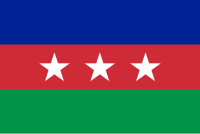
Back Аб’яднаны фронт вызвалення прыгнечаных народаў Byelorussian FULRO German Frente Unido para la Liberación de las Razas Oprimidas Spanish Front Unifié de Lutte des Races Opprimées Finnish Front unifié de lutte des races opprimées French フルロ Japanese រណសិរ្សសាមគ្គីដើម្បីរំដោះជាតិសាសន៍ក្រោមការគាបសង្កត់ Cambodian 피압박민족투쟁통일전선 Korean FULRO NB FULRO Polish
| United Front for the Liberation of Oppressed Races | |
|---|---|
| Front unifié de lutte des races opprimées | |
 | |
| Leaders | FLC leader: Les Kosem, Po Dharma[1] FLHP leader: Y Bham Enuol FLKK leader: Chau Dera |
| Dates of operation | 1964–1992 |
| Active regions | Central Highlands, Vietnam Mondulkiri Province, Cambodia |
| Allies | |
| Opponents | |
The United Front for the Liberation of Oppressed Races (FULRO; French: Front unifié de lutte des races opprimées, Vietnamese: Mặt trận Thống nhất Đấu tranh của các Sắc tộc bị Áp bức) was an organization whose objective was autonomy for various indigenous peoples and ethnic minorities in South Vietnam, including the Montagnards in the Central Highlands, the Chams in Central Vietnam, and the Khmer Krom in Southern Vietnam. Initially a political movement, after 1969 it evolved into a fragmented guerrilla group that carried on simultaneous insurgencies against the governments of South Vietnam under President Nguyen Van Thieu and North Vietnam of Ho Chi Minh. Opposed to all forms of Vietnamese rule, FULRO fought against both sides in the Vietnam War against the Soviet-aligned North (including the Vietcong) and the American-aligned South at the same time. FULRO's primary supporter during the 1960s and early 1970s conflict in Southeast Asia was Cambodia (under former monarch and then head of state, Prince Norodom Sihanouk), with some aid sent by the People's Republic of China during the period of the Third Indochina War.
Fractured by nature, FULRO was a symbolic alliance of various indigenous and ethnic groups in South Vietnam formed as an armed reaction against US-backed South Vietnamese President Ngo Dinh Diem and following right-wing military junta in Saigon's policies of systemic ethnic discriminations and land deprivations. Its nominal leader, an ethnic Rhade Y Bham Enuol, was put into prison by Ngo Dinh Diem in September 1958.[3] After 1963, Y Bham Enuol then remained exiled in Cambodia for the rest of the war, while former co-founder of the parent BAJARAKA, left-leaned Y Bih Aleo, became the Vice President of the National Liberation Front of South Vietnam (NLF) and leader of the Viet Cong's Montagnard Autonomy Movement in 1961.[4] The FULRO organized two Montagnard uprisings among the ranks of US-trained local CIDGs in September 1964 and December 1965, both were violently repressed by the South Vietnamese Army (ARVN). After the Vietnam War ended, aided by the Pentagon and CIA Postwar Psyop, the anticommunist wing of the FULRO under former US Special Forces interpreter Y Tlur Eban renewed the movement, this time against the newly-unified Socialist Republic of Vietnam.[5] Their guerilla bases moved to Cambodia after the Vietnamese invasion of Cambodia in 1979, which afterwards the FULRO strength diminished unrecoverably; by 1987, their movement died out inside refuge camps along the Thai-Cambodian border.[5]
The movement dissolved almost three decades later in 1992, when the last group of 407 FULRO fighters and their families handed in their weapons to the United Nations peacekeepers in Cambodia.
FULRO built its strength mainly by recruiting Montagnard CIDGs (mostly Rhade, Jarai, and Koho). Due to high-profile proximity and involvement of United States Special Forces (Green Berets) personnel with the Montagnard CIDGs and FULRO, South Vietnamese and later Socialist Republic of Vietnam governments deemed the FULRO to be a subversive movement used by the CIA to interfere with Vietnamese sovereignty.[6] Official American policy was however opposition to FULRO and not to jeopardize its allied relation with the South Vietnamese government, and in 1965 MACV General Westmoreland issued an instruction to order that US soldiers "should avoid all contacts with FULRO."[7][8]
- ^ a b c d Written by BBT Champaka.info (8 September 2013). "Tiểu sử Ts. Po Dharma, tác giả Lịch Sử 33 Năm Cuối Cùng Champa". Champaka.info.
- ^ Edward C. O'Dowd (16 April 2007). Chinese Military Strategy in the Third Indochina War: The Last Maoist War. Routledge. pp. 70–. ISBN 978-1-134-12268-4.
- ^ Salemink, Oscar (2003). The Ethnography of Vietnam's Central Highlanders: A Historical Contextualization, 1850-1990. University of Hawaii Press. p. 201. ISBN 978-0-8248-2579-9.
- ^ Salemink, Oscar (2003). The Ethnography of Vietnam's Central Highlanders: A Historical Contextualization, 1850-1990. University of Hawaii Press. p. 200. ISBN 978-0-8248-2579-9.
- ^ a b Kiernan, Ben (2017). Việt Nam: a history from earliest time to the present. Oxford University Press. p. 460. ISBN 978-0-19516-0-765.
- ^ Salemink, Oscar (2003). The Ethnography of Vietnam's Central Highlanders: A Historical Contextualization, 1850-1990. University of Hawaii Press. p. 204. ISBN 978-0-8248-2579-9.
- ^ Salemink, Oscar (2003). The Ethnography of Vietnam's Central Highlanders: A Historical Contextualization, 1850-1990. University of Hawaii Press. p. 205. ISBN 978-0-8248-2579-9.
- ^ Salemink, Oscar (2003). The Ethnography of Vietnam's Central Highlanders: A Historical Contextualization, 1850-1990. University of Hawaii Press. p. 210. ISBN 978-0-8248-2579-9.
© MMXXIII Rich X Search. We shall prevail. All rights reserved. Rich X Search